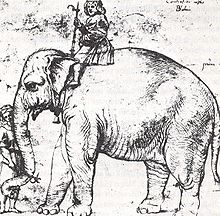History of elephants in Europe
This article includes a list of general references, but it lacks sufficient corresponding inline citations. (April 2024) |

Chronica maiora
, Part II, Parker Library, MS 16, fol. 151v
The history of elephants in Europe dates back to the time of the
Cyprus dwarf elephant, the pygmy elephant, the Naxos dwarf elephant and the Rhodes dwarf elephant survived longer, and the last Mediterranean elephant species survived on Tilos until about 4000 years ago.[1]
Subsequently the presence of actual elephants in Europe was only due to importation of these animals.
Overview
Europeans came in contact with live elephants in 327 BC, when
Seleucids fell to Rome had orders to hamstring every elephant they could capture, and while elephants performed in the circuses of Rome, Shapur
's war elephants in the mid-4th century numbered in the hundreds (Fox 1973 p 338).
Elephants largely disappeared from Europe after the Roman Empire. As exotic and expensive animals, they were exchanged as presents between European rulers, who exhibited them as luxury pets, beginning with
Harun ar-Rashid's gift of an elephant to Charlemagne
.
Examples
Historical accounts of elephants in Europe include:
- The 20[a] elephants in the army of Pyrrhus of Epirus, which landed at Tarentum in 280 BC for the first Battle of Heraclea, recorded by Plutarch's (in Lives), Polybius, Dionysius of Halicarnassus and Livy. "The most notable elephant in Greek history, called Victor, had long served in Pyrrhus's army, but on seeing its mahout dead before the city walls, it rushed to retrieve him: hoisting him defiantly on his tusks, it took wild and indiscriminate revenge for the man it loved, trampling more of its supporters than its enemies".[3] Coins of Tarentum after this battle also featured elephants.
- The 37 elephants in Rhône in October/November 218 BC during the Second Punic War, recorded by Livy.
- The first historically recorded elephant in northern Europe was brought by
- Abul-Abbas, the Asian elephant which Harun ar-Rashid gave to Charlemagne in 797 or 802. The animal died in 810, of pneumonia.
- The A. A. M. Duncan, Scotland: The Making of the Kingdom (1975), p. 128)
- The Cremona elephant presented to Frederick II, Holy Roman Emperor by Al-Kamil in 1229.
- The elephant given by war elephants did exist, though not ones made of stone. A carving of the elephant can be found on a contemporary miserichord in Exeter Cathedral. This animal may be the inspiration for the heraldic device 'Elephant and Castle', the arms of the Cutlers' Company of London, a guild founded in the 13th century responsible for making scissors, knives and the like. Its heraldry survived in an 18th-century pub-sign that in turn gave its name to a largely modern district in South London.
- In the 1470s King Christian I of Denmark founded a chivalric order, the Order of the Elephant, and had it confirmed by Pope Sixtus IV. The order takes its name from the battle elephants which symbolized the Christian Crusades. Today[update], it continues to be awarded under statutes established by king Christian V in 1693, amended in 1958 to permit the admission of women to the order.
- The elephant given by René d'Anjouabout 1477.
- The merchants of Cyprus presented Ercole d'Este with an elephant in 1497.
- Suleyman the elephant, a present from the Portuguese king John III to Maximilian II, Holy Roman Emperor. Travelling from Spain in 1551, it arrived in Vienna in 1552, but died in 1554.
- Raphaelhimself.
- Ceylon that became famous in early 17th-century Europe, touring through many countries demonstrating circus tricks, and sketched by Rembrandt and Stefano della Bella.
References
- Footnotes
- Sources
- ^ "Elephas tiliensis n. sp. from Tilos island (Dodecanese, Greece)" (PDF).
- ^ "Pliny the Elder, The Natural History, BOOK VIII. THE NATURE OF THE TERRESTRIAL ANIMALS., CHAP. 6. (6.) —WHEN ELEPHANTS WERE FIRST SEEN IN ITALY". www.perseus.tufts.edu.
- ^
ISBN 9780140088786.
The most notable elephant in Greek history, called Victor, had long served in Pyrrhus's army, but on seeing its mahout dead before the city walls, it rushed to retrieve him: hoisting him defiantly on his tusks, it took wild and indiscriminate revenge for the man it loved, trampling more of its supporters than its enemies in the process.
- ISBN 9780711228016.
- Saurer, Karl and Elena M.Hinshaw-Fischli. They Called him Suleyman: The Adventurous Journey of an Elephant from the Forests of ISBN 81-7871-029-3
- Robin Lane Fox, 1974. Alexander the Great. Chapter 24 contains an excursus on Alexander and the elephant in Europe,
- The Story of Süleyman. Celebrity Elephants and other exotica in Renaissance Portugal, Annemarie Jordan Gschwend, Zurich, Switzerland, 2010, ISBN 978-1-61658-821-2
- Scullard, Howard Hayes (1974). The Elephant in the Greek and Roman World. London: Thames and Hudson. ISBN 0-500-40025-3.
